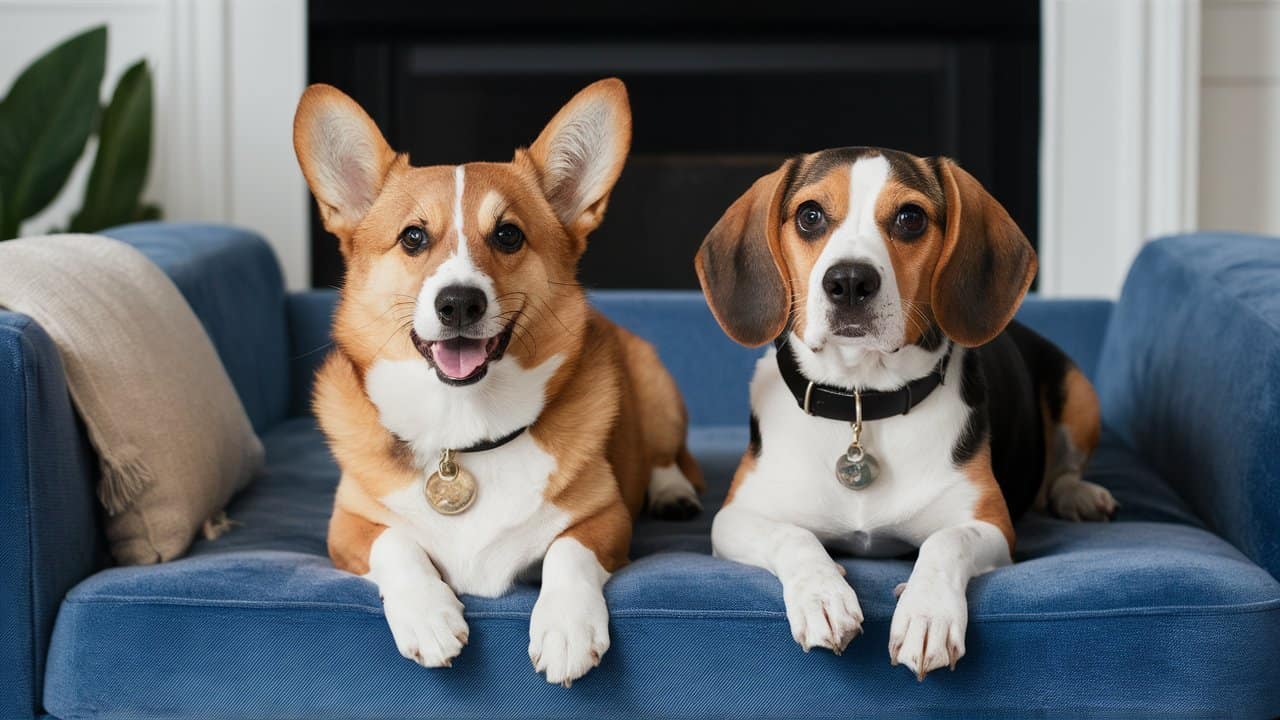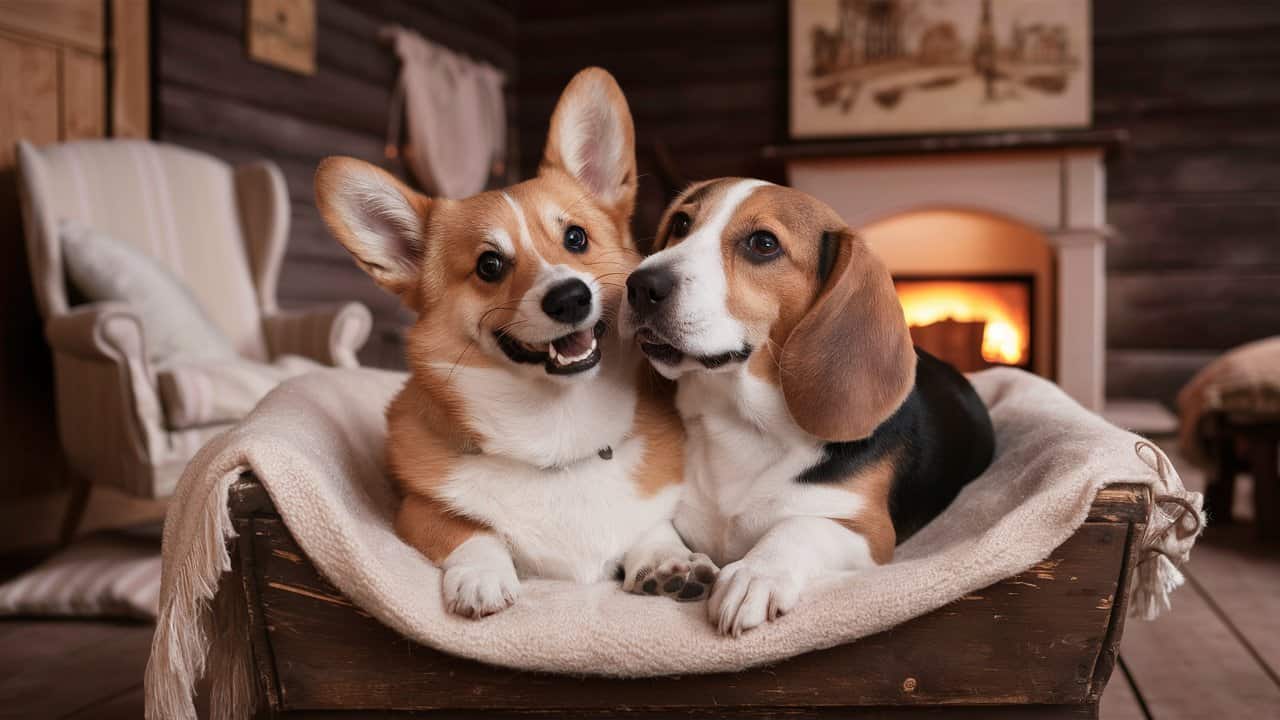The Beagle is known for its great sense of smell and tracking skills. They were bred to hunt in packs, so they enjoy company.
This makes them very social dogs who like being with people and other pets. They have a short coat that is easy to care for.
Corgis, on the other hand, come from Wales where they were used as herding dogs. They are smart and good at problem-solving tasks.
Their bodies are long with short legs which make them stand out in looks. Corgis have a thick double coat that needs more grooming than Beagles.
Visual Differences – Beagle vs Corgi
When you look at a Beagle and a Corgi, many things stand out. The first thing might be their ears.
Beagles have long, floppy ears that hang down by their cheeks. These soft ears can almost reach their nose if pulled gently forward.
Corgis, on the other hand, have shorter ears that stand upright on top of their heads.
Another clear difference is in how tall they are because of their legs. Beagles have sturdy legs that are medium in length, but Corgis’ legs are much shorter in comparison. This gives Corgis a very unique look as they move with short steps.
The body shapes between these two breeds also show big differences. A Beagle has a muscular frame which helps it run fast and be agile when hunting or playing games like fetch with its owner.
It looks strong and ready for action! But the Corgi has something special too—a long torso which makes it look quite different from most dogs you see around town or at the park.
Which Breed Is Right for You?
Choosing between a Beagle and a Corgi can be tough since they are both charming but very different. Here’s a simple guide to help you decide which breed suits you better.
Beagles
- Activity Level: Beagles are very active and need plenty of exercise. They were bred to run for miles and can keep up with you if you like jogging, biking, or any outdoor activity.
- Training: Beagles are sweet but can be stubborn. They are scent hounds, which means they follow their nose, sometimes getting them into trouble.
- Vocalization: Beagles bay instead of barking. They are very vocal, so be prepared for some noise.
- Weather: Beagles have short, single coats and can get cold in chilly weather. They need a bit of extra care in the winter.
- Social: Beagles are friendly and usually get along well with other dogs. However, they might not focus on people as much as other breeds.
Corgis
- Activity Level: Corgis are also active but in a different way. They love games like Flyball and agility trials. They don’t need as much exercise as Beagles but still enjoy staying active.
- Training: Corgis are highly intelligent and easy to train but can be headstrong. An untrained Corgi can become a nuisance, so consistent training is important.
- Vocalization: Corgis can be very barky, especially when bored. They need mental stimulation to prevent destructive behavior.
- Weather: Corgis have a double coat, making them well-suited for cold weather. They require regular brushing to maintain their coat.
- Social: Corgis are people-centric and love being involved in family activities. They can be territorial but usually get along with other family pets.
When choosing a dog, think about your activities, where you live, and your family.
If you’re always outside, a Beagle is good because they love to explore, but they need a yard. A Corgi is great if you like to play and chill; they’re okay in apartments or houses.

Both dogs need training: Beagles need more patience, and Corgis need you to be in charge. Beagles are friendly with kids and other dogs. Corgis like attention and are good with families but can be a bit bossy.
A Quick Overview – Beagle vs Corgi
Beagle | Corgi |
Height 13-16 inches (33-41 cm) | Height 10-12 inches (25-30 cm) |
Weight 20-30 pounds (9-13 kg) | Weight 22-31 pounds (10-14 kg) |
Coat Short, dense, and weather-proof | Coat Thick, medium length, water-resistant |
Temperament Friendly, Curious, Merry | Temperament Intelligent, Affectionate, Alert |
Trainability Eager to please, responds well to positive reinforcement | Trainability Highly trainable, responds best to firm and consistent training |
Lifespan 10-15 years | Lifespan 12-15 years |
Health Concerns Epilepsy, Hip Dysplasia, Eye Conditions | Health Concerns Intervertebral Disc Disease, Hip Dysplasia, Eye Conditions |
Family-friendly Yes; great with children and other pets | Family-friendly Yes; good with children and can be good with other pets if socialized properly |
Exercise Needs High; requires daily activity | Exercise Needs |
Breed History of Beagle & Corgi
The Beagle has a rich history that starts in England. They were bred as scent hounds. This means they used their noses to hunt. Beagles tracked small animals like rabbits. The breed became popular because of its strong sense of smell and stamina.

Historical figures loved Beagles too. Queen Elizabeth I had pocket-sized beagles called “Glove Beagles”. They could fit in her glove! These dogs hunted with the royals long ago.
Now let’s talk about the Corgi. Corgis come from Wales, which is part of the United Kingdom. People know them as herding dogs. Their job was to help farmers by moving sheep around fields.
There are two types of Corgis: Cardigan Welsh and Pembroke Welsh Corgi breeds.
- The Pembroke Welsh Corgi often lacks a tail.
- Both corgi breeds have short legs but are very strong.
A famous historical figure who loves corgis is Queen Elizabeth II of England. She has had more than 30 corgis during her reign!
Both dog breeds have been close friends to people for many years. Each breed has unique skills that helped humans long ago and still do today.
Appearance of Beagle & Corgi

Beagles have a distinct build. They are medium-sized dogs with sturdy bodies. Their height ranges from 13 to 15 inches at the shoulder.
Beagles have large brown or hazel eyes that give them a pleading look. Their ears are long and floppy, setting low on their head.
Corgis stand out with their unique stature. They are small to medium-sized but well-known for their short legs and long body. The Pembroke Welsh Corgi is one of the most popular types of Corgis. It often has no tail and its ears stand high and pointed.
People looking for a pet must think about these differences. Each breed’s appearance fits different life conditions and purposes too. For example, an apartment might be better suited for smaller dogs like some Corgis because of their size.
Coat & Colors of Beagle & Corgi
Beagles and Corgis have different coat colors and textures. A Beagle’s coat is usually tri-color with a mix of black, brown, and white. They can also be found in other color combinations like red and white or lemon and white.
In contrast, Corgis come in various shades too, including fawn, sable, red, or black and tan. The Cardigan Welsh Corgi even has merle patterns which are unique among the two breeds.
The texture of their coats is another distinct difference. Beagles have short-haired coats that are smooth to the touch. This makes grooming relatively easy because they only need regular brushing to keep their fur clean and free of dead hair.
On the other hand, Corgis possess a thicker double coat consisting of a soft undercoat beneath a coarser outer layer.
Both breeds have distinctive markings that set them apart from each other as well as from other dogs:
- Beagles often have a white tip on their tails called a “flag,” which helps hunters see them when they’re in tall grass.
- Cardigan Welsh Corgis may show unique merle coloring—a pattern made up of patches of lighter color interspersed within their darker base coat color.
Temperament of Beagle & Corgi
Beagles and Corgis show different temperaments. Beagles are known for their friendly and curious nature. They love exploring and often follow their noses, which can lead to mischief. This breed enjoys being around people, making them great family pets.
Corgis, on the other hand, are very alert and bold dogs. They were bred to herd cattle and tend to be more assertive than Beagles. Their strong personality makes them excellent watchdogs. Despite this boldness, they also have a loving side that families cherish.
These two dog breeds have an independent streak too. A Beagle’s independence means they might not always listen when called if something more interesting has caught their attention. Training requires patience because of their exploratory instincts.
Corgis express their independence through stubbornness sometimes. They like having a job to do and may try leading the way during activities.
Despite these traits, both breeds could serve as therapy or service dogs due to their intelligence and ability to form strong bonds with humans.
Trainability of Beagle & Corgi
Beagles and Corgis are both smart dogs. But their intelligence works in different ways when you train them. Beagles love to follow scents.
This can make training hard because they get distracted by smells around them. They might not listen if they catch a whiff of something interesting. Proper training can help, but it takes patience.
Corgis want to make their owners happy. This makes them easier to train than Beagles sometimes. They like learning new things and enjoy doing tasks for praise or treats.
Both dogs also need a leader who understands how they think and act during training sessions. The tendency of a beagle is to follow its nose over listening to commands at times while corgis may show stubbornness if not properly motivated or engaged due to their high energy level.
Exercise of Beagle & Corgi
Beagles and Corgis are both active breeds, but they need different kinds of exercise. A Beagle has a lot of energy because it is a hunting dog. It needs to run and play every day.
This helps them stay fit and keeps their mind sharp. They love long walks or games that let them use their strong sense of smell.
Corgis were made to herd animals, so they like moving around too. But they do not need as much running as Beagles do. Corgis can get by with shorter walks and some playtime at home or in the yard.
For a Beagle, you might want to try:
- Long hikes where they can explore
- Fetch games that make them run fast
- Scent work activities which are fun for their nose
Corgis would enjoy:
- Shorter but more frequent walks
- Training exercises that challenge their intelligence
- Playtime with toys that move, like balls or tugs
Both dogs will become overweight if they don’t move enough. So it’s important to find the right balance between rest and activity for each one.
Remember too much sitting around isn’t good for these breeds’ hearts or bodies. Make sure your furry friend gets enough time outside playing or working out.
Grooming of Beagle & Corgi
Beagles and corgis have different needs. A beagle’s coat is short, so they need less grooming. Corgis have a thicker coat that needs more care. Both dogs shed, but in their own ways.
A beagle sheds hair evenly throughout the year. Their short hair is easy to brush out. This means you won’t find lots of hair on your clothes or furniture. But corgis shed a lot more, especially during change of seasons. They have a thick undercoat that can get everywhere! It’s important to brush them often to keep this under control.
For both breeds, nail care is key for good health. Long nails can hurt a dog and make walking hard for them. Make sure you trim their nails regularly. Ear cleaning helps stop infections, which both breeds can get if not cared for right. Dental hygiene keeps teeth strong and prevents bad breath and disease.
Taking good care of your pet’s fur, nails, ears, and teeth will help keep them happy and healthy!
Feeding of Beagle & Corgi
Beagles and Corgis have different feeding needs. A Beagle is usually smaller than a Corgi. They need less food because of their size. But both breeds can gain weight if they eat too much.
For a Beagle, you might give them two cups of dog food each day. For a stockier Corgi, they may need more to stay healthy. It’s important to measure the right amount for your pet.
Both dogs love to eat and might overeat if given the chance. Owners should watch how much their beagle or corgi eats very carefully.
Each breed has its own dietary needs. Some foods that are good for one may not be good for the other.
A Beagle was bred to hunt, so it has lots of energy. They need food that gives them power but doesn’t make them heavy. Corgis were herding dogs with strong bodies but short legs. They don’t want too much weight on those little legs!
You also have to think about what makes these dogs sick from eating certain things. Some Beagles and Corgis can get allergies or stomach problems from some types of dog food. It’s best to talk with a vet about what foods are safe and healthy for your furry friend.
Puppy Prices of Beagle & Corgi Puppies

When you decide to bring a puppy home, cost is a big factor. Beagles and Corgis are both popular, but their prices can vary.
A Beagle puppy might cost between $400 and $1,000. On the other hand, a Pembroke Welsh Corgi, known for being friendly and active, may set you back more at around $600 to $1,200 from reputable breeders.
Prices change based on several things:
- The dog’s family tree or pedigree
- Where you live
- How well-known the breeder is
A top-notch pedigree will often mean a higher price because these dogs are bred for certain qualities.
Also, if the breeder has an excellent reputation or wins competitions with their dogs, they may charge more.
There are extra costs when getting your new furry friend too. These include important shots to keep them healthy (vaccinations), making sure they can’t have puppies of their own (spaying/neutering), and buying stuff like bowls and beds (initial supplies).
It’s not just about the purchase price; it’s also about being ready for these first-time expenses.
Remember that adopting from a rescue could be less costly than buying from a breeder. Sometimes you can find Beagles or even Pembroke Welsh Corgi dogs looking for homes in rescues.
Health Conditions and Concerns
Beagles and Corgis are both adorable breeds with their own set of health issues. Beagles often face problems like epilepsy, heart disease, and eye disorders.
They can also get overweight if not exercised enough. On the other hand, Corgis may deal with back issues due to their long bodies. They can suffer from hip dysplasia as well.
Most Beagles live around 10 to 15 years while Corgis have a similar lifespan. But this depends on how healthy they are throughout their lives. Both breeds need good care to stay healthy for as long as possible.
To keep these pups in tip-top shape, owners should take them for regular vet visits. This helps catch any health problems early on. It’s also important for preventing breed-specific ailments that could shorten their lives.
Final Thoughts
Beagles and Corgis are both great dogs, but they’re quite different. Beagles are known for their sharp noses and love of adventure.
They need space to explore and sniff around. Corgis, on the other hand, have strong herding instincts. They often try to herd people by nipping at their heels.
Before picking a dog, think about your lifestyle. Beagles do well with active families because they require lots of exercise. If you don’t give them enough activity, they might get into trouble out of boredom!
Corgis also need exercise but can adapt better to smaller spaces as long as they stay busy.
Remember what we said about health issues in the last section? Keep those in mind too when choosing your pet.
By meeting each breed in person, you can see which one matches your personality best. Maybe a Beagle’s boundless energy excites you or perhaps a Corgi’s cleverness wins you over.
Lastly, there is always a low chance that any dog might not be perfect for your home until you meet them face-to-face.

